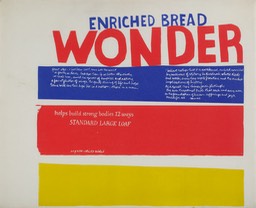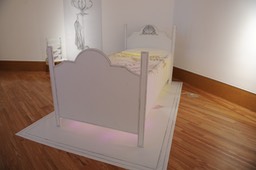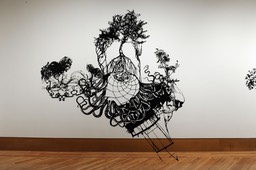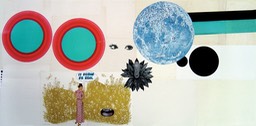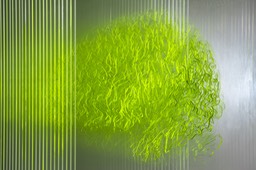Summer of Women
BY GEORGE FISHMAN
Forget the notion that Miami’s art scene withers in the summer heat. Current exhibitions at galleries and museums throughout region are a hotbed of activity. (And they’re air conditioned, thank goodness!)
Summer is also the theme of three exhibitions at the Patricia & Phillip Frost Art Museum FIU, where Jordana Pomeroy is director. She and curator Klaudio Rodriguez are celebrating “The Women of Summer” in ways that acknowledge the light and romance of the season but also place provocative messages beneath shimmery surfaces.
IN THE BEGINNING
“In the Beginning was the Word” fittingly conveys Sister Mary Corita Kent’s religious passion and the canny use of text in her socially driven works. “She is serious in every way, but ‘summertime’ in terms of color,” explained Pomeroy.
A nun and art teacher at Immaculate Heart College from 1936-68, Kent adopted the vibrant, catchy imagery of advertising, street signs and pop art to insistently call for social change and advocate for simple righteousness. A 1962 exhibition of Andy Warhol’s work in Los Angeles provided the aha! moment, and she adapted both the silkscreen medium and pop imagery to her activist designs.
The catchy jingles and color of food packaging echo in Kent’s work. “They’re snappy, fun. Everyone can recite them; you heard them on TV or on the radio. But then you dig deeper,” said Pomeroy. “When you see the word ‘WONDER,’ it’s not just Wonder Bread; it’s about the wonders of the world. It could be about the wonder of God.”
Despite liberal reforms in the Catholic Church’s pivotal Second Vatican Council in 1962, Kent’s marches with protesters and other overt political activism dismayed officials, who encouraged her to leave the order. In 1968, she moved to Boston and devoted herself entirely to creating art, including her landmark “Swash” design on a 150-foot-tall natural-gas tank.
Some works incorporate quotes from the Bible, President John F. Kennedy, Martin Luther King Jr., and Simon and Garfunkel. The Beatles’ lyric “Love is here to stay …” is appropriated in support of civil rights. In others, vernacular texts like “Do Not Enter” and “Wrong Way” are directed against the Vietnam War.
In many, the message is laced with irony. “ENRICHED BREAD” appears in all-caps on a print titled “they may have life.” Below, a diminutive scrawled text reads “so many hungry people …”
Kent’s work echoes in the punchy graphics and searing text of much protest and advocacy art of recent decades. Keith Haring championed AIDS research and protested anti-gay bias (IGNORANCE = FEAR) with cute but acerbic images in subways, on T-shirts and in galleries; Faith Ringgold uses texts, flags and faces to protest racism and extol the accomplishments of African Americans. Ai Weiwei, Kara Walker, Tanya Bruguera, Shepard Fairey and JR all advocate for social change, although the distinction between commentary and mobilization is often ambiguous.
“Artivism” is central to national organizations like Pangea Seed, advocating stronger conservation policies by commissioning murals from Mexico to New Zealand to Wynwood.Barefoot Artists, MLK Murals and True Mosaics organize community projects to generate civic pride and develop marketable skills. Miami-based eco-artist Xavier Cortada’s mangrove reforestation, performance, multimedia installations and permanent public art seek to influence awareness and behavior regarding the environment. Vietnam-born Huong, best known for anti-war murals, recently created a text-and-drawing installation in South Beach, inviting the public to boldly write their views on the elections.
“Kent’s work is as relevant now as when she made it,” Pomeroy said. With exhibitions at the Warhol, Frost, and Victoria and Albert museums, “She’s found fame posthumously, as so many women find fame after they turn 70…” If she were still working today, Kent might be generating animated GIFs or Facebook memes to protest the shootings of black youth. “She stood apart by her intention,” said Pomeroy, noting that this also separated her from her more sanguine and richly rewarded male counterparts.
RESONANCE/DISSONANCE
Eleven videos by six women are featured in “Resonance/Dissonance,” the Frost’s first major, multi-person video exhibition. It presents a focused sampling from international and locally recognized mid-career talents.
Rodriguez determined to choose works driven more by abstract, emotional content and sonic expression than by narrative. In a multi-stage process, he collaborated with Ibett Yanez, director of the de la Cruz Collection in the Design District. Before video exploded as an art medium, women were among its early adopters and experimenters.
In the works on view, audio plays an integral role that is often destabilizing, as when an elegantly dressed violinist (Susanne Winterling) delivers whines and screeches in her unsettling “Untitled” piece. Scores range from classical to silence, punk rock to … dissonance, while a summery nod comes from beanbag chairs laid out in one gallery for casual drive-in ambience.
SUDDENLY LAST SUMMER
AdrienneRose Gionta is both artist and curator. A graduate of FIU’s master’s program, the Frost hosted her 2014 thesis show. While planning the “Summer of Women,” Rodriguez ran into her at an opening. He explained his concept and asked, “Can you pull it off? Can you knock it out?”
Eagerly accepting the guest-curatorial challenge, Gionta’s first association with “women” and “summer” was Don Henley’s song “Boys of Summer.” Next, the Motels’ 1983 “Suddenly Last Summer” came to mind. She knew it well, but watching the video clinched it. She trusted her instinct to use the song as a touchstone (as did Rodriguez), then identified three artists to flesh out its bittersweet themes. She didn’t visit studios to make selections but gave artists the song and video and let them choose, adapt or create new work for their respective gallery installations.
Fort Lauderdale artist “Donna Haynes is unafraid of highly personal and emotional topics,” said Gionta during a tour. “Her work is very seductive visually, as well as in content.” The artist readily envisioned the Florida west coast of her childhood to stage a summer romance, although her own family typically spent the steamy months cooling off in her grandmother’s West Virginia house.
That’s where Haynes discovered “naughty” romance novels, like one glimpsed in the video. She removed pages containing “juicy bits” and carefully cut lacy silhouettes of flying birds and a flower-like mandala. Her intimate, beach cottage-like installation maintains a pale, “innocent” palette. A white four-poster bed glows from beneath, and crystals hang from the ceiling, casting diamond-like reflections like those dancing on the Gulf. Seashells are displayed on a white-painted wicker table; others are cast in clear resin and contain romantic phrases.
Continuing the mood (“I really did go for a little bit of that cheese factor,” said Haynes), a stop-action sunset animation is veiled by curtains that sway in a fan’s breeze. But Haynes’ final touch also conveys the song’s dark message of innocence lost. Next to her “chaste” bed, Haynes mounted a trompe-l’oeil graphite drawing of a negligee.
For Gionta, the song’s line about ”a space for a moment, a space for a time” evoked the playful childhood clubhouse spaces she created in her Brooklyn basement. She was drawn to the color, texture, pattern and structure of Miamian Michelle Weinberg’s work, which she knew from the Girl’s Club and other venues. The themes of young love and nostalgia were not lost on Weinberg, but in an email she wrote, her installation “was all about creating a simulated summer residency or summer rental environment, in which an artist can feel a sense of escape.”
In this show, she has created a generous studio-gallery environment that showcases her talents, both in finished products and process. Notebooks and digital prints, arrayed on a two-tier worktable, suggest the artist may resume work momentarily. Her sketches preview several “collections” of small sculptural pieces that playfully rework mid-century modern aesthetics. Examples include collage, construction, printmaking, a striking three-color rug; even a hand-printed jacket. Her hybrid style features artisan skills, freely blended with contemporary technology, including digital video animation.
Consistent with her improvised space, Weinberg’s collages marry disparate “found” elements including “feminine characters plotting escapes, communing with Nature or slipping the boundaries of Nature.” Weinberg also slips boundaries, working miniature to mural scale, in décor, fashion, gallery and public art. And guest curating.
As a northern city girl, Gionta, had used summer to reconnect with nature. She became acquainted with Leah Brown’s sculptures through South Florida exhibitions. Brown explores the interaction between dream and waking thought processes, using vivid depictions of the natural world. Her varied formats even include installations made of human hair. ”I connect to nature but definitely not at the same level that she does,” said Gionta.
For inspiration, Brown recalled a drive to Key West. The Overseas Highway skirts numerous islands with no access roads and encircled by impenetrable mangrove root systems. “They were such places of mystery and of specificity and I kept thinking about them … and they worked their way into my dreaming process,” she said. She drew and then laser-cut black museum board to create a set of meticulously detailed silhouettes, evocative of Victoriana and the Gothic South. She called her installation “Inaccessible Keys.”
Dense foliage, tangled roots, birds, an ancient serpent, skeletons, an alligator and other patterns and creatures animate the irregular-shaped vignettes. Several nearly hidden female characters provide “a continuation of the [dream] narrative in a new way for me,” Brown said. “For the first time, in this series I feel that the Florida landscape has really come through and showed itself as an influence.” She, in turn, vividly expresses the haunting power of that landscape.
ART MEETS SCIENCE
A fruitful partnership between the Frost art and science museums paired cognitive neuroscientist Angela Laird and visual artist Felice Grodin – both FIU faculty members. Their "brainstorming" and Grodin's sketches generated the design for a unique sculpture, Neural Networks, that imaginatively, elegantly and accurately represents the human brain. Laird provided an MRI scan. From this digital information, Andrea Perelli's team at BYO-Lab, a local prototype fabricator, worked with FIU's architecture department to laser cut a set of closely-spaced clear acrylic panels that correspond to the parallel "slices" of the scan. They painted its convoluted silhouette edges yellow-green, and the assembly offers an uncanny, virtual-reality-like presence. Its color, animation and beauty suggest both rippling, sun-lit seagrass... and an active brain. Wall text, a digital animation and brain-teasing artifacts – both scientific and occult – accompany the tabletop presentation.
This collaborative work, which bridges biology, technology and art, is the third Curious Vault Collaboration, organized by Kevin Arrow, art and collection manager at the science museum, and documented by writer Nathaniel Sandler. For the unveiling, Sandler moderated a lively conversation among the participants in a project that promises intriguing follow-ups.
Read more here: http://www.miamiherald.com/entertainment/visual-arts/article89939677.html#storylink=cpy
